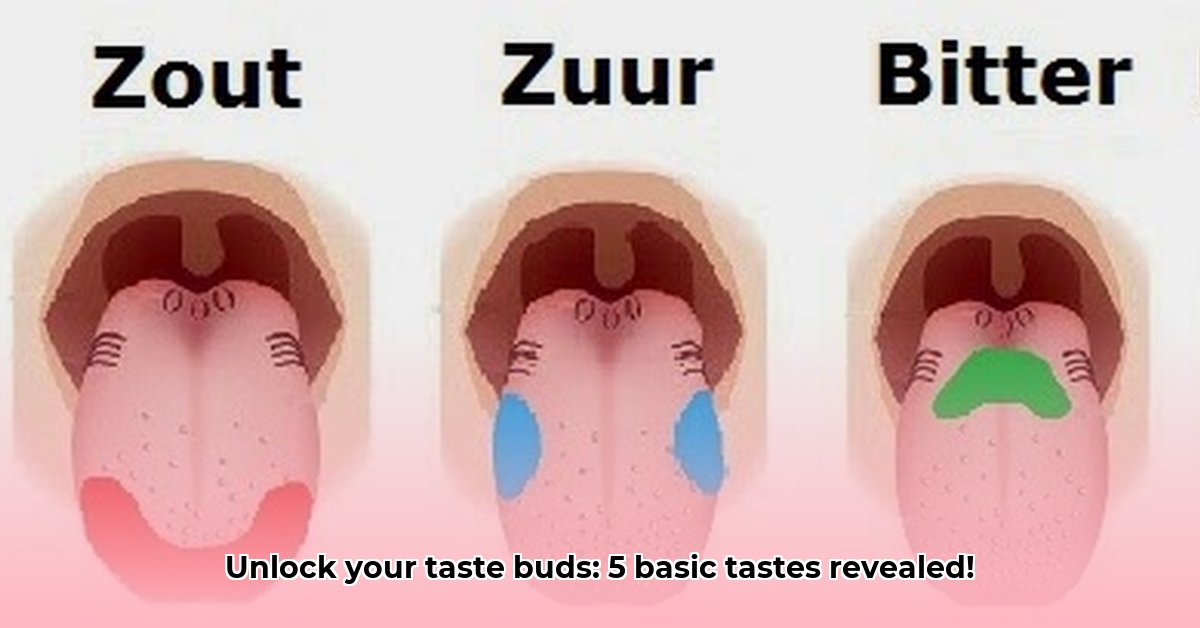
Ever wondered why that bite of biltong hits the spot, while a mouthful of bitterbessies leaves you wrinkling your nose? It's more than just personal preference, tjom; it's the incredible story of how millions of years of evolution shaped our taste buds. Our sense of taste, specifically the five basic tastes – De Vijf Basissmaken – sweet, sour, salty, bitter, and umami – is a powerful survival mechanism, a delicious tale woven into our DNA. Let's delve into this fascinating world of flavours.
De Vijf Basissmaken: Unlocking the Secrets of Taste
Our five basic tastes aren't just about enjoying a lekker braai; they're a crucial part of our survival story. Imagine our ancestors, eons ago, searching for food. Sweetness, lekker, signaled ripe, energy-rich fruits – vital fuel for survival. A burst of sweetness meant calories, the body's building blocks. Sourness, often a bit tart, acted as a warning system; it often indicated spoiled food, potentially harmful. Our tongues learned to shy away, protecting us from nasty surprises. Salty tastes were crucial for electrolyte balance.
Bitterness, often unpleasant, served as a crucial early warning system. Many toxic plants contain bitter compounds, and a sensitive aversion to this taste probably saved countless lives. Lastly, there's umami ("oo-MAH-mee"), that rich, savoury flavour, often found in protein-packed foods like meat and mushrooms. Our bodies recognised umami as a signal of growth and repair. Our taste preferences weren't formed overnight; they're a legacy passed down through generations.
How Your Tongue Decodes Flavour
Your tongue isn't just a muscle; it's a sophisticated organ packed with thousands of tiny taste buds, each containing specialized cells called taste receptor cells – think of them as tiny flavour sensors! When you eat, molecules from your food interact with these cells, triggering electrical signals that zoom to your brain. Your brain interprets these signals as the flavours you perceive. The intensity depends on the concentration of taste molecules and your individual genetic makeup. Some people naturally have more taste buds than others, leading to more intense flavour experiences – are you a supertaster?
Sweetness activates specific receptors that make us crave more; bitterness—often triggering an aversion response – is a built-in safety mechanism. This interplay of stimuli and response is the fascinating science behind our taste experience.
Culture’s Influence: A Flavourful Tapestry
While our instinctive responses to the five basic tastes are largely innate, what we enjoy is vastly shaped by culture and experience. What one person considers a culinary delight, another might find utterly unappetizing! This highlights how much our learned experiences influence our taste.
Consider the diverse global cuisines. From the fiery spices of Indian curries to the delicate flavours of Japanese sushi, every culture reflects generations of learned taste preferences. A taste for intensely spicy food isn’t something we're born with; it’s a learned behaviour. This interplay between nature and nurture creates a rich flavour map, as individual as a fingerprint.
Putting De Vijf Basissmaken to Work: Practical Applications
Understanding De Vijf Basissmaken has practical applications!
- Healthier Eating: By understanding our cravings for sweet and salty tastes, we can make healthier food choices – not eliminating them, but choosing healthier alternatives and mindful portion sizes.
- Cooking with Flair: Mastering the balance of De Vijf Basissmaken can transform your cooking. Experimenting with the interplay of sweet and sour, salty and umami, creates flavourful and harmonious dishes.
- Food Science and Innovation: Food scientists use this knowledge to develop more appealing and healthier options, reducing salt and sugar without compromising flavour.
The Future of Taste: Ongoing Discoveries
Research into taste perception is an ongoing field. Scientists continue to uncover new nuances, exploring the role of genetics, our environment, and even our gut microbiome. Some scientists even suggest there may be more basic tastes than we currently recognise! The study of taste is a dynamic field with new insights emerging all the time.
A Quick Guide to De Vijf Basissmaken
| Taste | Description | Examples | Evolutionary Role |
|---|---|---|---|
| Sweet | Sugary, pleasurable | Fruit, honey, candy, nectar | Rapid energy source; survival |
| Sour | Tart, acidic | Lemons, vinegar, unripe fruit | Indication of spoilage; potential Vitamin C source; warning signal |
| Salty | Savoury, mineral-like | Table salt, pretzels, seawater | Electrolyte balance; essential for many bodily functions |
| Bitter | Usually unpleasant | Coffee, dark chocolate, grapefruit, leafy greens | Potential toxicity warning; also signifies certain beneficial compounds |
| Umami | Savoury, meaty, rich | Meat, cheese, mushrooms, soy sauce, tomatoes | Protein source; essential for growth and repair |
The exploration of De Vijf Basissmaken is a delicious journey combining scientific understanding with the pleasure of discovering new flavours. So, gaan – go ahead and savour the taste!